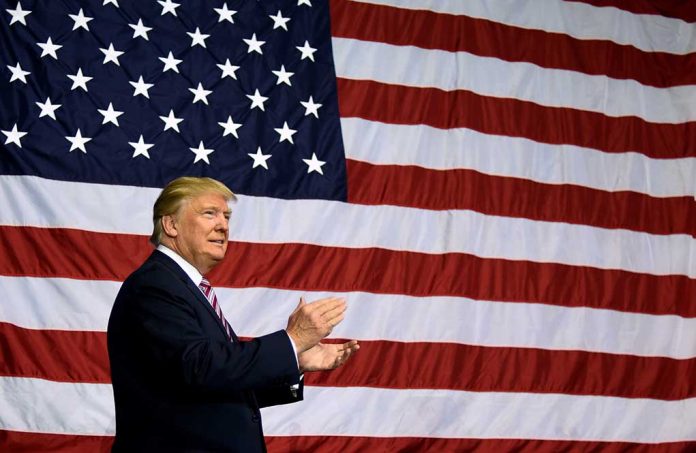
In a bold statement, Donald Trump has proposed a 25% tariff on all Mexican imports to tackle border security issues.
At a Glance
- Trump threatens a 25% tariff on Mexican imports to curb illegal immigration.
- Prediction of tariff efficacy at “100 percent,” with increases to 50% or even 100% if needed.
- Criticism arises over potential economic repercussions of tariffs.
- Trump’s first call as president would be to Mexican President Claudia Sheinbaum.
Trump’s Tariff Proposal
During a speech in North Carolina, former President Trump put forward the potential introduction of a 25% tariff on Mexican imports. This action aims to pressure Mexico into controlling illegal immigration and drug trafficking. Trump hinted at increasing tariffs to 50% or even 75% if necessary, stating these economic measures are essential for enhancing border security and reducing crime.
The significance of this proposal is underscored by the trade relationship between the U.S. and Mexico. In 2022, trade was valued at $855 billion, with $500 billion comprising Mexican imports. In response to the tariffs, economists caution about rising U.S. goods costs, though Trump argues this may benefit domestic businesses by protecting industries and potentially boosting local manufacturing.
Potential Impact and Historical Context
Reflecting on history, Trump employed similar intentions during his first term, which resulted in negotiations and enhanced Mexican border security. Critics, such as Vice President Kamala Harris, warn of possible economic repercussions, likening them to a “national sales tax.”
“One of the first calls I’m going to make is to Mexico. ‘You stop letting people come in through our border,'” said Donald Trump at his Raleigh, NC, rally.
The Mexican government, led by President Claudia Sheinbaum, remains committed to cooperating with the incoming U.S. administration regardless of election outcomes. The Mexican Foreign Ministry emphasizes their migration strategy remains independent from U.S. policy changes. Trump’s past rapport with Mexico’s President López Obrador suggests possible dialogue possibilities, despite the differing political climates.
Looking Ahead
Trump vows to address the border crisis immediately, conveying intentions to speak with Sheinbaum on his first day. The proposition includes deploying Mexican soldiers to the southern border to stem the flow of illegal immigrants and narcotics. Trump’s confidence in this strategy remains steadfast, largely driven by his administration’s historical negotiations with Mexico.
“We’re being invaded by Mexico. But now we have a new president of Mexico. Supposed to — a very nice woman, they say. I haven’t met her. And I’m going to inform her on day one or sooner that if they don’t stop this onslaught of criminals and drugs coming into our country, I’m going to immediately impose a 25 percent tariff on everything they send into the United States of America,” asserts Trump.
The potential impact of these tariffs remains a topic of national debate, especially concerning the broader economic effects on consumers and trade. Trump’s rally in North Carolina is part of his broader campaign strategy emphasizing these issues across battleground states, further highlighting the significance of border security in his overall policy strategy.








